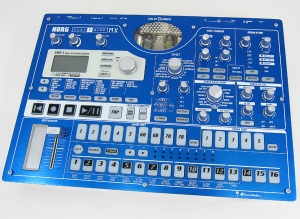
Today I was out and about and I went into a used goods shop called “Santa” in Nagano-city, Japan. I was surprised to see that there was a big store wide sale and that they were possibly going out of business soon. Now I almost “never” find anything in this store other than overpriced junk but occasionally I find some computer floppy disks or some interesting toys for the kids. They sometimes have old music gear but it’s always the kind of stuff nobody wants or just musical toys. Well, today it was a different matter because sitting in the shop was a Casio CZ-5000 that looked to be in excellent condition. The price on it was $25 which made me scratch my head for a minute and wonder why. I then realized that I didn’t know much of anything about the Casio CZ-5000 and that I better run home and do some checking.
Later I discovered it was potentially a nice 80’s oriented synth that I could have some fun with. What I was also excited about was that on Yahoo Auction Japan, the Casio CZ-5000 was selling between $350 to $450. I thought Wow! I could at least buy it and sell it later to maybe make some extra cash. I raced back to the used shop and brought it up to the counter. The gentleman immediately told me it didn’t work. I said ok that’s fine but can I at least plug it in and check the power? He said sure and knowing this shop might not have headphones I brought my own which he was surprised to see.
The Casio CZ-5000 powered up nicely. Indeed the synth didn’t seem to want to make any sound. I then figured out how to access and change the patches. Now I got sound coming through my headphones and it sounded pretty decent. Like with previous synths I’ve purchased at used shops in Japan, the sales staff usually don’t know anything about these keyboards. In addition, when a Casio CZ-5000 is mixed in among other Casio kids keyboards they start thinking all Casios are the same. I don’t know why the clerk said the keyboard was broken, because it sounded great to me.
Finally the sales clerk let me have it for $10 perhaps feeling sorry I don’t know. Even though there was a big sale going on, I guess he just wanted to get rid of it. For whatever reason I was more than happy to take it off his hands. As I drove home I realized that I didn’t really have a chance to check if everything indeed worked. I started to worry a bit, but then realized that this was only 10 bucks.
Later in the evening I powered the Casio CZ-5000 up again and had a ton of fun jamming on it for about two hours. The Casio CZ-5000 is a really fun synth to play around with. I found that the sequencer worked great. In fact all of the buttons, volume, chorus, etc. worked as they should. I ran the CZ-5000 through the Korg A1 effects processor I recently picked up and boy did it come to life. I noticed that bumping up the on board chorus while adding some portamento made the sounds much more analog sounding. I particularly liked the vibrato effect as well. I then did some basic tweaking of the presets and even created a few new sounds. They saved nicely into the internal memory.
All in all, the Casio CZ-5000 plays beautifully and it’s just in fantastic condition. It should fit in nicely with my current 80’s synth setup and I’m looking forward to seeing what else it can do.




